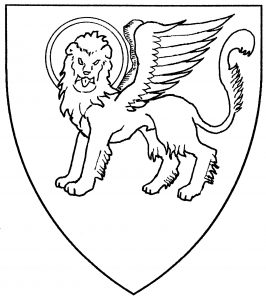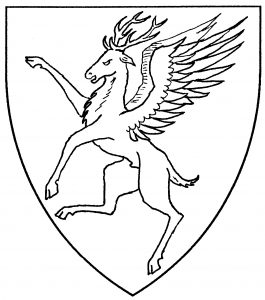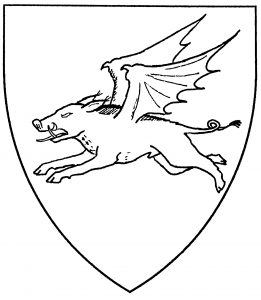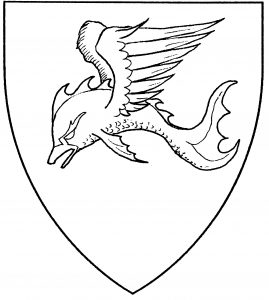There are special terms for some winged monsters. A haloed winged lion may be blazoned a “lion of St. Mark”; it is found in the civic arms of Venice, 1413 [Conz.Const. cciii]. (St. Mark was the patron saint of the city.) A haloed winged ox may be blazoned an “ox of St. Luke”; it is found in the arms of Caravello, 1413 [Conz.Const. cliii]. Both evangelists’ monsters are frequently shown maintaining a book, that being their attribute, but such cases are nonetheless explicitly blazoned.
Rampant winged monsters may be blazoned “segreant”, since that term may be applied to any monster “half-bird, half-beast”; in that case, the posture of the wings is defined by the term. Winged monsters statant or couchant do not need their wings’ posture blazoned, either: the wings will be addorsed by default, that being their most distinguishable posture. The term “volant”, however, is ill-defined for non-birds, and should not be used for winged monsters; instead, the posture of the body should be blazoned in a standard way, with the wings’ position made explicit (e.g., a “winged lion courant, wings elevated and addorsed”).The illustrations show a lion of St. Mark statant guardant; a winged stag segreant; a bat-winged boar courant, wings elevated and addorsed; and a winged dolphin, wings addorsed. For specific entries, see humanoid monster (angel), pegasus, pithon. See also winged charges.
Jon de Cles bears: Gules, a winged camel trippant argent.
Jean Pierre de Sabre bears: Or, a winged fish volant sable.
Harold von Auerbach bears: Vert, a bat-winged boar salient argent.
Hastini Chandra bears: Or, an Indian elephant passant gules, winged sable.
Jamie MacRae bears: Purpure, a winged stag rampant to sinister argent.
Niall Kilkierny bears: Vert, a winged sea-lion rampant Or.



